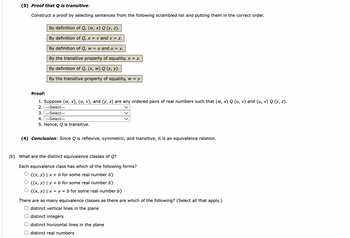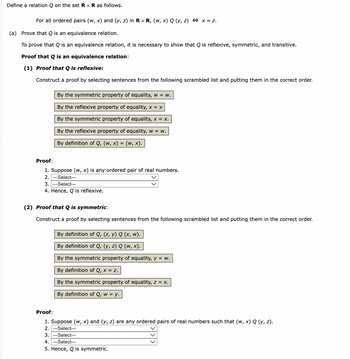(3) Proof that Q is transitive: Construct a proof by selecting sentences from the following scrambled list and putting them in the correct order. By definition of Q, (w, x) Q (y, z). By definition of Q, x = v and v = z. By definition of Q, w = u and u = y. By the transitive property of equality, x = Z. By definition of Q, (x, w) Q (z, y). By the transitive property of equality, w = y Proof: 1. Suppose (w, x), (u, v), and (y, z) are any ordered pairs of real numbers such that (w, x) Q (u, v) and (u, v) Q (y, z). Select--- 2. 3. 4. Select--- Select--- 5. Hence, Q is transitive. (4) Conclusion: Since Q is reflexive, symmetric, and transitive, it is an equivalence relation. (b) What are the distinct equivalence classes of Q? Each equivalence class has which of the following forms? O {(x, y) | x = b for some real number b} O {(x, y) | y= b for some real number b} O {(x, y) | x = y = b for some real number b} There are as many equivalence classes as there are which of the following? (Select all that apply.) ☐ distinct vertical lines in the plane ☐ distinct integers ☐ distinct horizontal lines in the plane ☐ distinct real numbers Define a relation Q on the set R x R as follows. For all ordered pairs (w, x) and (y, z) in Rx R, (w, x) Q (y, z) ⇒ x = z. (a) Prove that Q is an equivalence relation. To prove that Q is an equivalence relation, it is necessary to show that Q is reflexive, symmetric, and transitive. Proof that Q is an equivalence relation: (1) Proof that Q is reflexive: Construct a proof by selecting sentences from the following scrambled list and putting them in the correct order. By the symmetric property of equality, w = w. By the reflexive property of equality, x = x By the symmetric property of equality, x = x. By the reflexive property of equality, w = w. By definition of Q, (w, x) = (w, x). Proof: 1. Suppose (w, x) is any ordered pair of real numbers. 2. ---Select--- 3. ---Select--- 4. Hence, Q is reflexive. (2) Proof that Q is symmetric: Construct a proof by selecting sentences from the following scrambled list and putting them in the correct order. By definition of Q, (z, y) Q (x, w). By definition of Q, (y, z) Q (w, x). By the symmetric property of equality, y = w. By definition of Q, x = z. By the symmetric property of equality, z = x. By definition of Q, w = y. Proof: 1. Suppose (w, x) and (y, z) are any ordered pairs of real numbers such that (w, x) Q (y, z). 2. ---Select--- 3. Select--- 4. Select--- 5. Hence, Q is symmetric.
(3) Proof that Q is transitive: Construct a proof by selecting sentences from the following scrambled list and putting them in the correct order. By definition of Q, (w, x) Q (y, z). By definition of Q, x = v and v = z. By definition of Q, w = u and u = y. By the transitive property of equality, x = Z. By definition of Q, (x, w) Q (z, y). By the transitive property of equality, w = y Proof: 1. Suppose (w, x), (u, v), and (y, z) are any ordered pairs of real numbers such that (w, x) Q (u, v) and (u, v) Q (y, z). Select--- 2. 3. 4. Select--- Select--- 5. Hence, Q is transitive. (4) Conclusion: Since Q is reflexive, symmetric, and transitive, it is an equivalence relation. (b) What are the distinct equivalence classes of Q? Each equivalence class has which of the following forms? O {(x, y) | x = b for some real number b} O {(x, y) | y= b for some real number b} O {(x, y) | x = y = b for some real number b} There are as many equivalence classes as there are which of the following? (Select all that apply.) ☐ distinct vertical lines in the plane ☐ distinct integers ☐ distinct horizontal lines in the plane ☐ distinct real numbers Define a relation Q on the set R x R as follows. For all ordered pairs (w, x) and (y, z) in Rx R, (w, x) Q (y, z) ⇒ x = z. (a) Prove that Q is an equivalence relation. To prove that Q is an equivalence relation, it is necessary to show that Q is reflexive, symmetric, and transitive. Proof that Q is an equivalence relation: (1) Proof that Q is reflexive: Construct a proof by selecting sentences from the following scrambled list and putting them in the correct order. By the symmetric property of equality, w = w. By the reflexive property of equality, x = x By the symmetric property of equality, x = x. By the reflexive property of equality, w = w. By definition of Q, (w, x) = (w, x). Proof: 1. Suppose (w, x) is any ordered pair of real numbers. 2. ---Select--- 3. ---Select--- 4. Hence, Q is reflexive. (2) Proof that Q is symmetric: Construct a proof by selecting sentences from the following scrambled list and putting them in the correct order. By definition of Q, (z, y) Q (x, w). By definition of Q, (y, z) Q (w, x). By the symmetric property of equality, y = w. By definition of Q, x = z. By the symmetric property of equality, z = x. By definition of Q, w = y. Proof: 1. Suppose (w, x) and (y, z) are any ordered pairs of real numbers such that (w, x) Q (y, z). 2. ---Select--- 3. Select--- 4. Select--- 5. Hence, Q is symmetric.
Elements Of Modern Algebra
8th Edition
ISBN:9781285463230
Author:Gilbert, Linda, Jimmie
Publisher:Gilbert, Linda, Jimmie
Chapter1: Fundamentals
Section1.7: Relations
Problem 22E: A relation R on a nonempty set A is called asymmetric if, for x and y in A, xRy implies yRx. Which...
Related questions
Question
need help

Transcribed Image Text:(3) Proof that Q is transitive:
Construct a proof by selecting sentences from the following scrambled list and putting them in the correct order.
By definition of Q, (w, x) Q (y, z).
By definition of Q, x = v and v = z.
By definition of Q, w = u and u = y.
By the transitive property of equality, x = Z.
By definition of Q, (x, w) Q (z, y).
By the transitive property of equality, w = y
Proof:
1. Suppose (w, x), (u, v), and (y, z) are any ordered pairs of real numbers such that (w, x) Q (u, v) and (u, v) Q (y, z).
Select---
2.
3.
4.
Select---
Select---
5. Hence, Q is transitive.
(4) Conclusion: Since Q is reflexive, symmetric, and transitive, it is an equivalence relation.
(b) What are the distinct equivalence classes of Q?
Each equivalence class has which of the following forms?
O {(x, y) | x = b for some real number b}
O {(x, y) | y= b for some real number b}
O {(x, y) | x = y = b for some real number b}
There are as many equivalence classes as there are which of the following? (Select all that apply.)
☐ distinct vertical lines in the plane
☐ distinct integers
☐ distinct horizontal lines in the plane
☐ distinct real numbers

Transcribed Image Text:Define a relation Q on the set R x R as follows.
For all ordered pairs (w, x) and (y, z) in Rx R, (w, x) Q (y, z) ⇒ x = z.
(a) Prove that Q is an equivalence relation.
To prove that Q is an equivalence relation, it is necessary to show that Q is reflexive, symmetric, and transitive.
Proof that Q is an equivalence relation:
(1) Proof that Q is reflexive:
Construct a proof by selecting sentences from the following scrambled list and putting them in the correct order.
By the symmetric property of equality, w = w.
By the reflexive property of equality, x = x
By the symmetric property of equality, x = x.
By the reflexive property of equality, w = w.
By definition of Q, (w, x) = (w, x).
Proof:
1. Suppose (w, x) is any ordered pair of real numbers.
2. ---Select---
3. ---Select---
4. Hence, Q is reflexive.
(2) Proof that Q is symmetric:
Construct a proof by selecting sentences from the following scrambled list and putting them in the correct order.
By definition of Q, (z, y) Q (x, w).
By definition of Q, (y, z) Q (w, x).
By the symmetric property of equality, y = w.
By definition of Q, x = z.
By the symmetric property of equality, z = x.
By definition of Q, w = y.
Proof:
1. Suppose (w, x) and (y, z) are any ordered pairs of real numbers such that (w, x) Q (y, z).
2. ---Select---
3. Select---
4.
Select---
5. Hence, Q is symmetric.
Expert Solution
This question has been solved!
Explore an expertly crafted, step-by-step solution for a thorough understanding of key concepts.
This is a popular solution!
Trending now
This is a popular solution!
Step by step
Solved in 1 steps with 2 images

Recommended textbooks for you

Elements Of Modern Algebra
Algebra
ISBN:
9781285463230
Author:
Gilbert, Linda, Jimmie
Publisher:
Cengage Learning,

Elements Of Modern Algebra
Algebra
ISBN:
9781285463230
Author:
Gilbert, Linda, Jimmie
Publisher:
Cengage Learning,